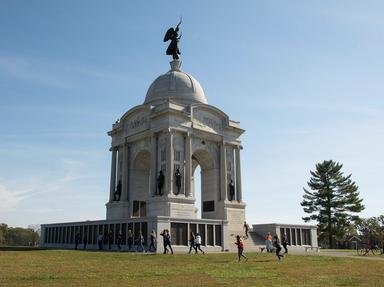Quiz Answer Key and Fun Facts
1. What was the most peculiar thing about the disposition of troops on the first day of the Battle of Gettysburg?
2. Union (USA) veteran John L. Burns was a civilian volunteer, and at nearly 70 years of age, the oldest combatant on either side at Gettysburg, serving with distinction on the first day. In which war did John Burns first serve the United States?
3. Viewed as a battle in its own right, how large an engagement was the First Day of Gettysburg?
4. Confederate (CSA) general Robert E. Lee had been in command of the Army of Northern Virginia for about 25 months by the beginning of the Battle of Gettysburg. How long had his opponent, Union (USA) general George G. Meade been in command of the Army of the Potomac?
5. On Day Two of the Battle of Gettysburg, the men of the 20th Maine Volunteers charged into history with their well documented defense of the Union left flank, at Little Round Top. What almost forgotten, and nearly contemporaneous action involving the 157th New York Infantry saved the Union's right flank?
6. Many of the battle sites on the Union left on Day Two of the Battle of Gettysburg have distinctive names. The Devil's Den is unusual because its name predates the battle by decades. What gave this patch of broken rock its sinister sounding name?
7. The heaviest, bloodiest fighting of Day Two at Gettysburg occurred in two adjacent parcels of land, together comprising less than 30 acres/12 hectares. What two plots named for their agricultural products saw almost 30,000 men suffer nearly 20,000 casualties in under six hours?
8. Day Three of the Battle of Gettysburg began with a pair of Confederate cavalry attacks. The main attempt occurred at East Cavalry Field and was an attempt to exploit the successes of Pickett's Charge from the Union rear. Two of the most famous cavalry commanders in American history were on the field. Who were they?
9. The legendary "Pickett's Charge" was the denouement of Day Three of the Battle of Gettysburg. Confederate Brigadier General Lewis Armistead led his troops to the crest of Cemetery Ridge before he was killed and his command overwhelmed. A monument stands near the farthest point of Armistead's advance. What is this monument called?
10. Casualties on both sides of the Battle of Gettysburg were massive. The victorious United States of America would not see casualties so high from a single engagement again until World War II. What island battle, fought late in the Pacific Theater, produced casualty numbers eerily similar to Gettysburg? There goes the flag!
Source: Author
Jdeanflpa
This quiz was reviewed by FunTrivia editor
bloomsby before going online.
Any errors found in FunTrivia content are routinely corrected through our feedback system.
